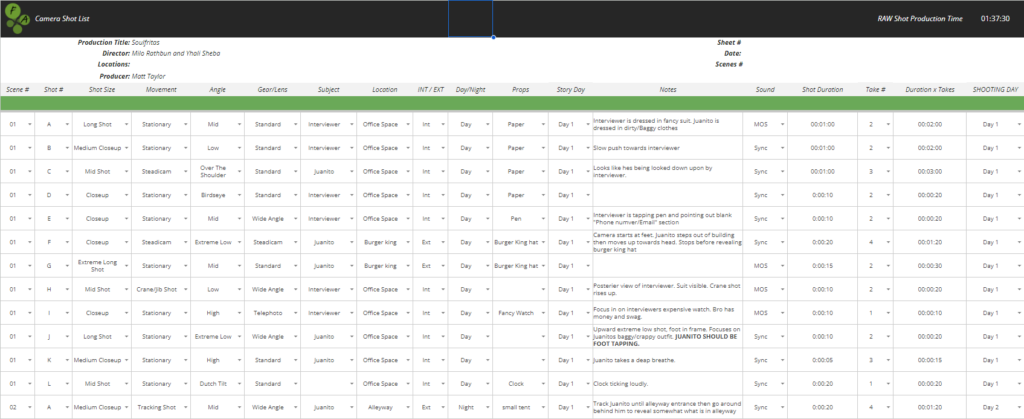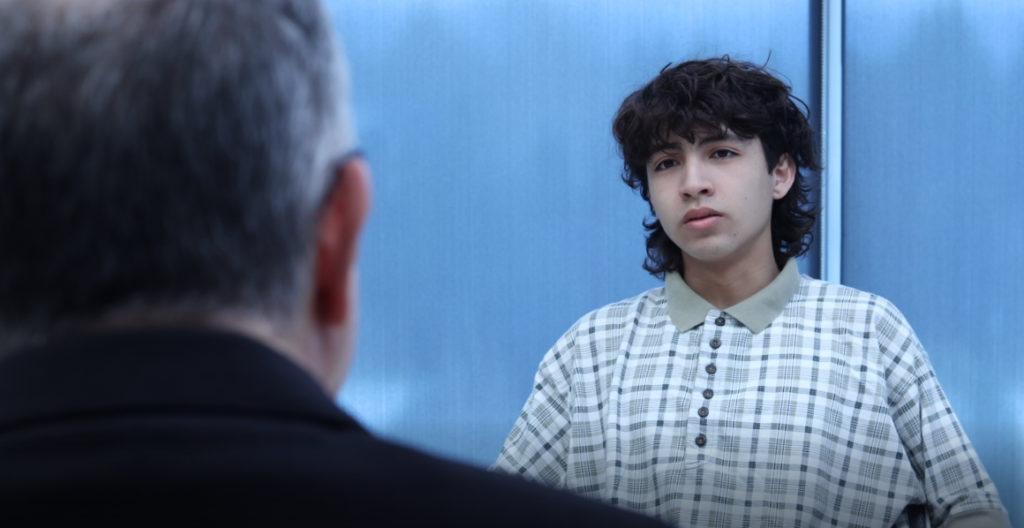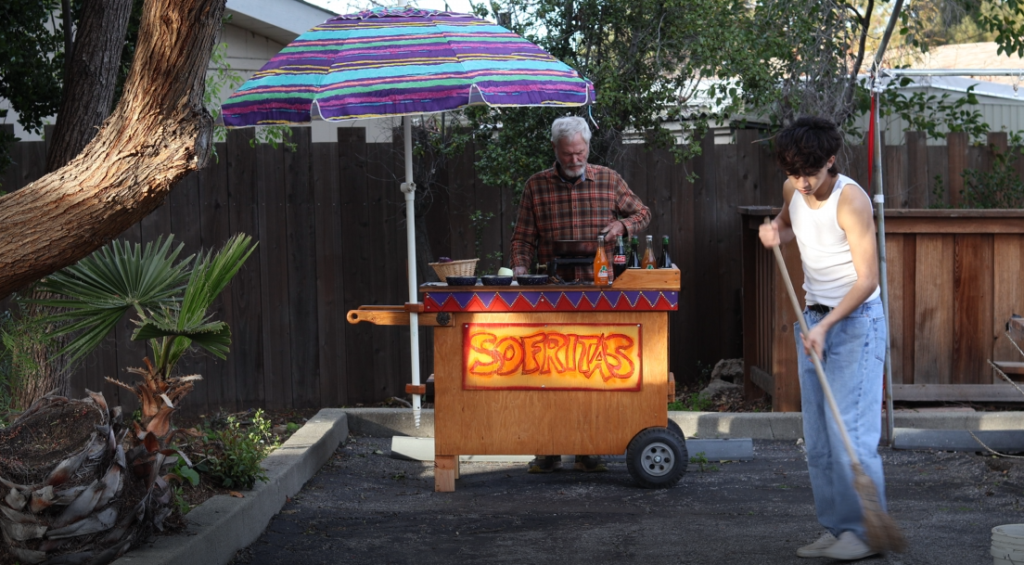Honing the Craft
The narrative project in the film was by far the most intense, and easily took the most effort. Creating an entire short film with dialogue was an incredibly daunting task. We were warned in advance by Mr. Taylor that it would be the hardest we would ever work on a project in our lives. With the magnitude of the project, we had to approach it bit by bit and started off by working on smaller video assignments to help us hone the skills that we would later use in the production of the narrative.
The first mini-assignment we worked on was the 1 Minute Movie; the idea behind the project is pretty self-explanatory, but it had a creative twist. We first partnered up into small groups and created storyboards for the short story, then, right before we went to go film, Mr. Taylor had us swap ideas with the group next to us. This essentially meant that we now had to film an entirely new idea, which we had to interpret in our own way based on the storyboard. After a very confusing session of filming, we then returned to the classroom to begin editing. However, once again, we were met by Mr. Taylor, who asked that we swap our SD cards with another new group, and edit a third, completely different film. This assignment challenged us to use our skills in the three factors of production, with minimal context regarding what we are creating. Ultimately, all of the films ended up being really funny and unpredictable, and every student participated in some way in the creation of each short. If you are able to draft, film, and edit, another individual’s production with no insight into what you are creating, then surely doing those same steps in your own film will be much more straightforward.
The second assignment we were tasked with was the one-period film, where we were randomly assigned into groups of three and given only one class period to create a film from start to finish. Working on such a time crunch was extremely challenging and stressful, but it made this assignment extremely fun. My group decided to film an interaction between a “dealer” and his client, but the addicting product he sells is rather unexpected. This project was also the first time we had the chance to use and experiment with our new DSLR cameras, which were 4k and autofocusing. In the end, our lack of familiarity with this equipment made our project outcome a little experimental, but we were very privileged to be the first ones to use these new cameras.
The senior narrative would also be our first time using real industry-grade lighting equipment in production. However, this meant that we needed a thorough explanation and experience using this equipment to ensure we were well-versed in how to use it. In an effort to do so, we took part in the lighting scavenger hunt, where we used a mixture of tungsten, fluorescent, and LED lights alongside diffusers and filters to gather as many different types of lighting shots as possible.
Film Mode
After spending a little over a month practicing the needed skills, we began to work on the beast itself, the senior narrative. We began our journey by each creating our own film titles and loglines, which are one-sentence summaries that capture the premise of a film. We then pitched our ideas in a class discussion for feedback; it was then that I first heard the word “SoulFritas,” when pitched by a fellow student and close friend of mine, Milo Rathbun.
When a homeless teenager finally catches his big break and finds a job, an unexpected mentor helps him kindle an undiscovered passion for cooking, and teaches him to live from the soul.
Although I didn’t know it at the time, SoulFritas would become one of the biggest aspects of my life over the next several months. Seeing similarities to the movie Chef, I immediately fell in love with Milo’s idea, and we decided to partner up to turn this simple logline into a film about cooking that revolved around Mexican culture. We started by developing the idea into a short synopsis.

One of the things we quickly realized about the production of our senior narrative was the need for crew. Things such as lighting, audio, and slating all require meticulous attention, and hence, garner a need for people to take on those roles on set. Unlike junior narrative, our senior narrative would require full-on crews to aid in our production. Mr. Taylor explained to us that these crews need to function in unison, like clockwork, and hence, urged us to practice working together through several assignments. The most notable, however, was the Dialogue Scene, where we were given a screenplay by Mr. Taylor, and had to form small film crews, with each member taking a turn doing every role in production. Despite the lack of continuity in these projects, having the opportunity to practice these skills would prove to be pivotal in the production of our actual films.
Towards the end of our first semester, we were tasked with the first major step in creating our films, the preproduction package. As a part of this package, me and Milo had to fully develop a screenplay, as well as a shortlist and shooting schedule. The first rendition of our screenplay wasn’t very polished, and me and Milo quickly realized that there was no room for slacking on this project. We spent the next several weeks revising our script and creating a developed story around the idea of SoulFritas. This meant countless hours of continuous writing; at a certain point, me and Milo had spent so much time working together that our brains had pretty much synced, and we no longer needed to verbally communicate as all our ideas were exactly the same. The time and effort dedicated to perfecting this screenplay was truly worth it, and the outcome is something I am very proud to say I have written.
Following the creation of our final screenplay, me and Milo underwent the process of lining the script, meaning we went through it and mapped out corresponding shots for each and every scene. Additionally, we also color-coded every single character, prop, location, and more to ensure that we were organized during production. We then used our lined script to create our shotlist, which was a spreadsheet that described each shot in detail, when and where it would be filmed, whether or not it needed audio, and how many takes we expected it to take. The shotlist consisted of almost 120 shots and was by far the most tedious part of the preproduction package, but proved to be very helpful on set.

The final part of our preproduction package was the schedule, where we mapped out all of our scenes into shooting days. During this process, we theorized potential film locations and also tried to predict how much time the film day would take, considering set up for equipment and other logistical aspects.
Working on all these different elements was extremely time-consuming, and we found ourselves working at Freestyle from 10 AM to 6 PM on the last day of the winter semester. But after all the hard work was finally done, we presented it all to Mr. Taylor and received the green light to begin the production of SoulFritas.

The production of SoulFritas would quickly become the most difficult task we would ever try to accomplish in film. We started by selecting our actors. We chose to have our close friend Miguel Ramirez play the role of our main character Mateo, as we thought he would be able to commit himself to the role despite a minimal acting background. For our other main character, Alvino, the owner of the food cart and Mateo’s mentor, we decided to cast Richard Rathbun, Milo’s father, who has been the star of several previous freestyle productions. Because of Richard’s deeply rooted Hispanic background and unique life experiences, we thought he would introduce an element of culture and creativity that our film needed.

One immediate issue we faced that halted our production was a lack of props. Our film was oriented around a food cart, which you would typically see used by street vendors in Mexico. However, our access to this type of prop was extremely limited, which meant only one thing, me and Milo had to build it ourselves. We spent several weeks constructing a food cart using scrap wood and salvaged materials with the help of Milo’s father.

Once we settled upon our actors and introduced them to their roles, we began filming in February. On set, we encountered many challenges with operating all our equipment; since we were creating a movie about food, it introduced a completely unexpected factor that confined the extent of our filming. At times, filming everything became overwhelming and seemed impossible, and I remember shooting days being the cause of immense anxiety, but we approached it bit by bit and took the time we needed to bring our film to life in the way we imagined. Over the following months of filming, me and Milo were able to improve our skills as directors and were able to better lead our crew and elevate the level of our production. After several months of filming and meticulous editing, many nights of sweat and tears, countless unanticipated roadblocks, and a lot of help from our classmates, SoulFritas was finally completed.
Overall, the process of creating the Senior narrative held true to what Mr. Taylor said. It undoubtedly was the hardest and largest project I’ve ever worked on, and nothing comes close. In fact, the process of making this film was so complex, that even while making this website, I couldn’t fit in everything I wanted to say. However, to me, there was more behind the senior narrative than just creating a film; this project challenged us to exceed the expectations that were set before us and commit everything we had to something greater than just ourselves. Of all the things I have created here at Freestyle, this film is my magnum opus. I believe it will stand the test of time the most and is something I will be extremely proud to show to family, friends, and even my future kids (if that ever happens). These past several months of work are something I wouldn’t trade for the world, and have taught me that if I am willing to truly apply myself and give something everything I have, I can go beyond what I thought I was capable of.
